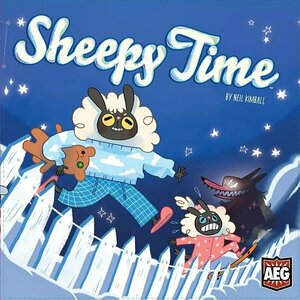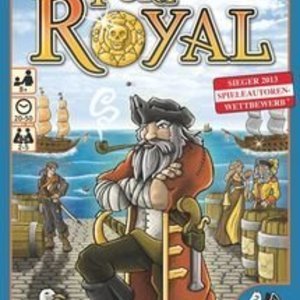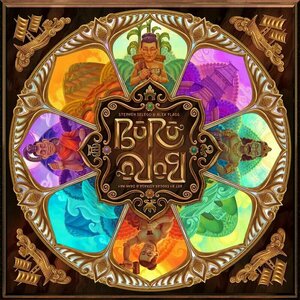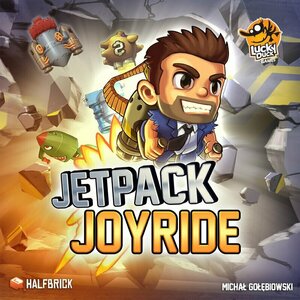Purple Phoenix Games (2266 KP) rated Sheepy Time in Tabletop Games
May 27, 2021
Disclaimer: We were provided with a copy of Sheepy Time for the purposes of this preview. What you see pictured below are the retail components. -L
Sheepy Time is a push-your-luck game in which players take on the roles of Dream Sheep, tasked with helping humans fall asleep. Played over a series of rounds, players will take turns racing their Sheep around the board, using special Dream powers, and avoiding the Nightmare that lurks around the board. The player that earns the most points (as described in the rules) will be declared the dreamiest sheep of all! To setup for a game, place the board within reach of all players and attach the Fence between spaces 10 and 1. Place the scoreboard and Pillow Reference tile nearby, and give all players a Sheep, Wink, Pillow, and Zzz tokens in their chosen color. Select one of the three provided Nightmares to use this game, shuffle their cards into the deck of Sheep cards, and place the Nightmare meeple in the center of the board. Shuffle the Dream tiles, drawing and placing one randomly on spaces 1 and 5 of the board, and reveal four more tiles to create a market. Place all Pillow tokens on the 40 Winks space of the scoreboard, choose a starting player, and the game is ready to begin!
Each round of Sheepy Time is broken into two phases: the Racing phase, and the Resting phase. To begin the Racing phase, all players will draw 2 cards into their hand. A turn consists of 4 steps: Play a card, Use Dream tiles, Resolve Fence crossing, and Draw cards. The first action you will take on your turn is to play a card from your hand. Most cards will have you move your Sheep around the board a set number of spaces, or will give you the option to ‘Catch some Zzz’s’ (place one of your Zzz tokens on a Dream tile in play). The next step, if applicable, is to use Dream tiles. Dream tiles provide special/extra abilities that can be beneficial to you. In order to use a Dream tile, however, you must have a Zzz token on it – remove your Zzz token from the tile to use its power. So you’ve got to decide when to move your Sheep, or when it’s necessary to Catch some Zzz’s! The third step is to resolve Fence crossing, if applicable. If a cards movement causes your Sheep to cross the Fence, you immediately gain 5 Winks (on the Scoreboard), and decide whether to keep playing this round or ‘Call it a Night.’ If you decide to keep playing, you move to step 4, and draw a new card into your hand. If you Call it a Night, you will discard your hand, and sit out for the remainder of this Racing phase.
If at any point in the Racing phase, you draw a Nightmare card, it must immediately be revealed and resolved. The Nightmare moves around the board, much like the Sheep, but it will Scare any Sheep that it passes! Being Scared once is ok, but if you were to be Scared AGAIN, you get Woken Up, lose all Winks for this round, and are out of the Racing phase. If the Nightmare completes a lap of the board and crosses the Fence before all players have Called it a Night, the remaining players get Woken Up. How risky are you willing to be once the Nightmare comes into play? That’s for you to decide. Once all players have either Called it a Night or been Woken Up, the Racing phase ends. Check the scoreboard for a winner – when a player earns enough Winks in the Racing phase to surpass their Pillow token. If nobody has met that requirement, players will lower their Pillow tokens by the amount specified on the Pillow Reference tile. The lower you can get your Pillow token, the fewer Winks you need to get to win in future rounds! When all Pillow tokens have been adjusted, the game moves to the Resting phase. In this phase, each player will have the choice to either add a new Dream tile to the board, or to Catch 2 Zzz’s. In turn order, players can select one of the Dream tiles from the market to place on an open space of the board, or place 2 Zzz tokens on Dream tiles in play. When everyone has performed their action, the round ends and a new Racing phase begins. Play continues in this manner until one player has been declared the winner!
I’m not typically a fan of push-your-luck games, but Sheepy Time really surprised me! Yes, that mechanic is definitely present in the gameplay, but there is also quite a bit of strategic variability that makes turns feel a little more controlled. The Dream tiles in play will always be different, providing unique abilities to help give you a strategic boost during play. And you always have 2 cards to decide between to play – you are not limited to only one course of action each turn. So yes, there is a riskiness involved with how many laps you think you can get, can you avoid the Nightmare, etc. But there is also a light element of strategy that makes the game more exciting for me. The gameplay itself is also very smooth and intuitive. The turn order makes sense and the flow of the game is pretty seamless. It is fast to teach and learn, and even though the box says 30-45 minutes, it feels fast to play.
Let me touch on components for a minute. As I said earlier, this is a retail copy of the game, and the production quality is great. The cardboard components are nice and thick, the wooden meeples are large and cute, and the overall art style reflects the theme and lightness of the game well. I want to mention that the insert is nice as well – I know it doesn’t effect the gameplay, but it makes set-up/tear-down quick and efficient. AEG definitely knocked it over the fence (get it?) with the production of this game!
So where does Sheepy Time fit into my collection? I think it’s a great game to use to introduce newer gamers to the hobby. The rules and gameplay are not overwhelming, but they offer more of a modern gaming feel than some of the older classics. I would even say that this game can be used with younger gamers as well – take out the Dream tile powers, and just race to see who can earn the most Winks before the Nightmare gets them, or something like that! It is really accessible for everyone, and that earns a big thumbs up from me. So if you’re not quite sure what to think of this game based on the theme/art style, I can assure you that the gameplay is quite excellent. When Sheepy Time hits retail, make sure you jump at the chance to play this game. Definitely don’t sleep on it.
Purple Phoenix Games (2266 KP) rated Port Royal in Tabletop Games
Jun 12, 2019
Port Royal is the central hub for trading and commerce in the kingdom. Ships from distant countries come in to trade, and crew-members-for-hire wander the docks looking for work. Do you have what it takes to make a name for yourself in this bustling port? Put your bargaining skills to the test to find out!
DISCLAIMER: There are several expansions to this game, but we are not reviewing them at this time. Should we review them in the future we will either update this review or post a link to the new material here. -T
Port Royal is a card drafting game of press-your-luck in which players are trying to amass 12 or more Influence Points. Each turn is played in two phases: the Discovery Phase and the Trade and Hire Phase. During the Discovery Phase, the active player draws cards one at a time to create the Harbor for that turn. The cards revealed will either be Characters, Ships, Missions, or Tax cards. The active player can draw as many or as few cards as they would like, with one catch – if you reveal a ship with a flag matching one already in the Harbor, the turn is a bust and all cards are discarded! Think wisely before trying to push your luck when creating the Harbor! If you’re too risky, you could bust, but if you play it too safe, you won’t have many card choices for the next phase. During the Trade and Hire Phase, players interact with cards in the harbor. The number of cards players can take depends on the number of different ships in the Harbor. Players can hire characters by paying their hiring cost in gold, can discard ship cards and collect gold for performing a “trade,” or can complete Mission cards if they have the required symbols on their hired cards. The Discovery Phase is performed by the active player alone, but the Trade and Hire Phase can be performed by each player, in order, after the active player. If you decide to act on another player’s turn, you must pay them one gold coin. The game ends at the end of a round in which one player has amassed 12 or more Influence Points, collected from Character and Mission cards. The player with the most points wins!
One thing that I really like about Port Royal is that it’s a competitive game, but not a confrontational game. Besides paying to act on another player’s turn, there’s not a lot of player interaction, and as someone who can get pretty competitive, I really appreciate that. Yes, we are competing against each other, but with so little interaction, I’m more focused on my own strategy and cards than I am in trying to sabotage my fellow players. Another thing I like about Port Royal is the push-your-luck aspect of the Discovery Phase. I like it more than other push-your-luck games because all decisions are made by the active player – you’re not having to bluff or directly compete with another player when drawing your Harbor cards. It’s still a game of chicken, but against yourself. There’s still the element of push-your-luck, but it feels a little more safe than nerve-wracking.
All that being said, what I don’t like about Port Royal is the actual gameplay. Since there’s so little player interaction and the entire Discovery Phase is performed by one player alone, it feels like there’s a bit of downtime. Unless you’re the active player, you only get to act during half of every turn, so time is spent just sitting and watching other players. It ultimately all comes down to how quickly everyone performs their turns, but there’s just not a ton of engagement in my opinion. Don’t get me wrong – it’s a neat game. It just feels a little boring to play sometimes. It also takes some time to build up momentum to successfully execute a strategy. Everyone starts with 3 gold coins, but most cards cost more, and depending on when you get to act in the Trade and Hire Phase, any cards you could have afforded may already have been taken. So it might take several rounds before you’re able to really begin implementing a solid strategy, with the first few rounds just being a card-grab.
For the most part, I enjoy playing Port Royal. It’s mildly strategic, but the lack of interaction can make it feel a little stale sometimes. It’s not a game I pull out every single game night, but it’s one that I would most likely play if someone suggested it. Purple Phoenix Games gives Port Royal a buccaneer’s 7 / 12.
https://purplephoenixgames.wordpress.com/2019/04/16/port-royal-review/
Purple Phoenix Games (2266 KP) rated Buru in Tabletop Games
Feb 22, 2021
Buru (http://burugame.com/)is a mid-weight economic worker placement game with a large dose of bidding thrown in for fun. In it players are visitors to the island sent to compete to become the governor of Buru by hiring indigenous peoples to assist with tasks, by providing fish for the peoples, pleasing the island’s elders, and by paying homages to the spirits of the land. The emissary who can utilize all their resources efficiently and impactfully will be deemed governor of Buru and winner of the game.
DISCLAIMER: We were provided a prototype copy of this game for the purposes of this review. These are preview copy components, and I do not know for sure if the final components will be any different from these shown. Also, it is not my intention to detail every rule in the game, as there are just too many. You are invited to download the rulebook, back the game through the Kickstarter campaign, or through any retailers stocking it after fulfillment. -T
To setup, follow the instructions in the rulebook. There are just too many steps to detail here and the rulebook is fantastic. Once setup, the play area should look similar to the photo below.
The game of Buru lasts five rounds, and each round consists of five phases of the day: Dawn, Morning, Noon, Afternoon, and Dusk. At the end of the fifth round the game is over and players will tally points to arrive at the winner.
During the Dawn phase players will flip over the top two Decrees tokens from the middle of the main circular board. These Decrees will be placed in certain areas and are worth bonus points or other advantages for the round. Also during this phase the Forest cards will be reset from the previous round. Once complete play moves to the Morning phase.
In the Morning players will be sending out their numbered Explorer tokens (from 1-5) onto the various board areas in turn starting with the current Emissary (first player). Each player will place one of their Explorer tokens at a time until each player has only one Explorer token left. Players may place multiple Explorers in a location to increase their bid for majority, but these Explorer tokens are placed face-up (literally with the face showing and the number on the board not showing) so that their values are hidden. Once Explorers are placed, play moves to the Noon phase.
At Noon the people must fish for food and have lunch. The leftover Explorer token that was not used in the Morning is then revealed and its value is converted to fish. Fish are needed to recruit islanders and are converted into other resources. Fish are tracked on the individual player boards. After a hearty lunch play continues into the Afternoon.
The Afternoon is where much of the action in Buru takes place. During this phase the Explorer tokens that were placed in the Morning are revealed and players take actions in each area by order of majority in each area. First the highest-bidding player will claim their chosen action space, then the next highest bidder, and so on. The Forest is resolved first. Players reveal the Explorer tokens in the Forest and whichever player has majority in this area is able to place their tokens a claim space on the board and will receive a Forest card of their choice. Forest cards are typically resources immediately earned by the player. Resources include Clay, Palm Leaves, and Ebony. The player with majority also earns the favor of Gunung (green spirit) and takes its giant statueeple.
Next, the Shore is resolved in the same manner. The Shore is where players may use their supplies of fish to recruit islanders to their taskforces and carry out tasks. The majority leader in this area chooses a space to place their Explorer tokens and resolves the action. This could include purchasing islander cards and refreshing the offer of islander cards in whichever order the player chooses. The player with the majority also earns the favor of Banyu (blue spirit) and takes its giant statueeple.
The Village is the area where islanders are able to complete tasks. The majority leader in this area chooses a space and takes the actions. These actions include activating islanders for the actions printed on the bottom of their cards and possibly even earning more fish. The player with the majority also earns the favor of Manuk (orange spirit) and takes its giant statueeple.
Finally, The Sacred Lake is resolved in the same manner. Here players are able to pay tributes to the spirits in order to earn bonuses from them. The majority leader in this area chooses a space to place their Explorer tokens, earns an immediate Esteem (VP tracked along the outer edge of the board), and takes the action of the space claimed. These spaces offer opportunities to pay tribute to one or more of the spirits as well as earning an Elder card, which provides conditions for earning bonus points at the end of the game. When a spirit is tributed they offer bonus Esteem cards and other benefits to be used. Once this area is completely resolved and players have all taken their turns play moves onto Dusk.
In Dusk players will reset the board for the next round of play. Players retrieve all their Explorer tokens from the board and untask their islanders that have completed tasks this day. After the fifth round the game is over and players tally their scores from their position on the Esteem track, any spirit Tribute cards earned, and Elder card point conditions met. The player with the most points will be crowned the winner!
Components. Okay, I have to give a giant shout-out to the team at Crafty Games. This is one of the highest-quality prototypes I have ever played in terms of component quality. When I opened the game box all components were separated into baggies and card cases and LABELED with the number of components, the titles, and even a picture of the components to be placed within. I don’t even organize my games to this level and I feel I am a tad OCD about my game organization. Kudos here. But also the components are all fine quality and the finished product promises to be just spectacular if this is what is received as a prototype.
I love the art and art style throughout this game. It is difficult to have theme shine through in a very Euro-style game, but I did feel the theme here. The art is very suggestive of island life, and Crafty Games even hired Cultural Consultants to assure all avenues are culturally appropriate. What a great call. I wish all publishers would be so thorough.
The gameplay is also quite stunning. The game just flows so naturally and everything makes complete sense. Of course you need to collect natural resources before recruiting islanders before asking said islanders to complete tasks before you pay respects to their spirits. I like the flow, and after a couple rounds I no longer needed the rulebook as a crutch.
I have very much enjoyed my plays of Buru for many reasons. The game is absolutely gorgeous. The art sings and truly adds to the gameplay. The rules are not light, but not over my head, and I appreciate that. The choices given to each player are crunchy without being too burdensome, and players of many skill levels will be able to find joy contemplating when and where to send their Explorers in each area. The game builds up to a big ending where many points are scored from places unknown to opponents and bulleting ahead from last place to first from exploiting bonus cards is so satisfying.
It is easy to understand why I love this game and would certainly recommend it to all gamers. If you have been looking for something a little heavier in your collection but don’t want to go TOO heavy, please do yourself a favor and consider backing Buru. Crafty Games has been working on some truly great games here the past couple years and I am excited to see where Buru ends up after another undoubtedly successful Kickstarter campaign. I will always be up for a game of Buru, and I hope to play it often as the years continue.

Dark Stories
Games and Entertainment
App
ATTENTION! THIS GAME IS MEANT TO BE PLAYED WITH FRIENDS IN PERSON. IF YOU ARE ALONE YOU CANNOT...
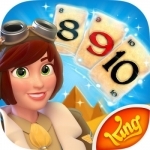
Pyramid Solitaire Saga
Games and Entertainment
App
Pyramid Solitaire Saga, from the makers of Candy Crush Saga & Farm Heroes Saga! Deal with the...
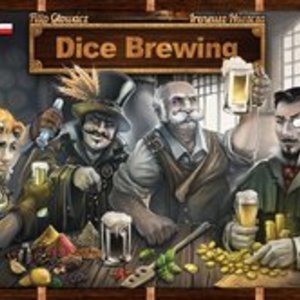
Dice Brewing
Tabletop Game
Dice Brewing is a dice-building game in which you manage resources and brew beer to become the beer...
Boardgames BeerGames DiceGames BrewingGames 2014Games Thirstygames

Poker Heroes: Brawl, Evolve, Dominate! BCG
Games and Entertainment
App
Are you ready for world domination? Jump into the fray as you command a devastating squad of heroes...

RollerCoaster Tycoon® Touch™
Games
App
Create, customize and rule your theme park kingdom in RollerCoaster Tycoon® Touch™. "Easily...
@trackie
Purple Phoenix Games (2266 KP) rated Jetpack Joyride in Tabletop Games
Jan 8, 2020 (Updated Jan 8, 2020)
Originally a mobile game, Jetpack Joyride follows our main character, Barry, as he attempts to escape a top-secret lab with a stolen jetpack! He must avoid being hit by zappers, annihilated by lasers, and blown away by missiles in the process. If Barry succeeds, he escapes with not only the high-tech jetpack, but also with as many gold coins and other top-secret gadgets as he can get his hands on! So the risk is definitely worth the reward. But if Barry is unable to escape, he will face the consequences for his unauthorized joyride… In all honesty, I had never heard of Jetpack Joyride before I Kickstarted the board game version, so I downloaded it on my phone to see how it plays. Do you remember Flappy Bird? The mobile version of Jetpack Joyride is kiiiinda like that, but more exciting and way less infuriating. It’s free to download in the App Store and Google Play Store, so check it out if you’re interested! Anyway, back to the board game version. The premise is the same as the app – you have to create a path for Barry to use for his escape from the lab, utilizing the gadgets available to you and collecting gold coins on your way.
DISCLAIMER: We are using the Kickstarter Deluxe version of the game. We do have the expansions from the KS campaign, but will not be using those for this review. Also, we do not intend to cover every single rule included in the rule book, but will describe the overall game flow and major rule set so that our readers may get a sense of how the game plays. For more in depth rules, you may purchase a copy from the publisher directly or from your FLGS. -T
Jetpack Joyride is a real-time game of tile placement in which players are racing to see who can complete their run (path through the lab) the fastest. The game lasts for 3 runs, and points are earned throughout all runs. To setup, each player receives a set of 4 lab sector cards and sets them on the table in front of them in numerical order, 1-4. Three mission cards (cards that score points at the end of the run) are revealed and available for all players. Players may also have gadgets, available only to them, to help score extra points. When a run begins, all players grab translucent polyominoes (like matte versions of bits from Blokus) from the common pool and place them on their lab cards to create an unbroken path through the lab. There are specific placement restrictions that I will leave for you to discover in the rulebook. The game has no set time limit for each run, but it is a race to complete a path before your opponents. At the end of the run, points are tallied for completed missions and gadget cards. Easy, right? Here’s a small twist – before starting the next run, all players pick up their lab cards and pass them to the player on their left. So each run, players are looking at new cards and must find new paths through the lab! New mission cards and gadgets are revealed before subsequent runs as well. The player with the most points at the end of all 3 runs is the winner!
Jetpack Joyride is a fast-paced, exciting, and surprisingly strategic game that keeps all players engaged and entertained. And that’s what I love about it. First of all, real-time games are always high-energy, at least in my opinion. It’s nearly impossible to stay calm and collected when you’re literally racing against your opponents! Jetpack Joyride is definitely not a passive game, and there’s so much action and excitement that you sometimes forget you’re literally just laying tiles on cards. The next thing I love about this game is how deceptively strategic it is. Laying tiles to form a legal path across cards is not complicated, but doing so while also trying to earn extra points by completing missions (like placing 3 tiles of the same shape in a row, for example) adds a strategic element that you don’t expect. You’re not only trying to finish your run the fastest, but you’ve also got to fulfill the requirements for multiple mission and gadget cards too. One misplaced tile could decimate a run for you, so you’ve always got to be thinking several tiles in advance.
Going along with that, another neat thing about Jetpack Joyride is that all players are drawing tiles from a common pool. There is a finite number of tiles, and a specific number of the different shapes, so if the shape of tile you need is gone from the pool, you’re outta luck! You have to think and move quickly, otherwise you might get knocked out of a run, and that costs you valuable end-game points. For such a simple game, Jetpack Joyride also has a lot of variability. All lab cards are double-sided, and can be mixed and matched in any combination, as long as they are in a numerical set of 1-4. There are so many possibilities, chances are you won’t ever play with the same card combo twice….and if you do, chances are you won’t remember it 😛 All of these aspects elevate this game from a simple party game to a strategically fun game that can be played with any player count.
Overall, I think Jetpack Joyride is great. After my first play, I rated it a 4+, but after a few more I’ve changed my rating to a 5. As you can see from our scores above, Travis and our guest judge Luke enjoyed it as well. It’s a nice, light game that can be used as a filler between heavier games, or as a main-event game all on its own. Definitely a game I will use with newer gamers, and the strategic side will keep me coming back for more. I think Jetpack Joyride will get a lot of playtime from me, and it was worth my investment on Kickstarter. Purple Phoenix Games gives it a jet-powered 15 / 18.
Purple Phoenix Games (2266 KP) rated Aroma in Tabletop Games
Feb 20, 2021
Aroma is a board game that originates from an essential oil company wishing to produce a board game utilizing its oils. Designer Odd Hackwelder then crafted a board game utilizing said essential oils that can be played four different ways. That’s right, Aroma is a game with four different play modes. Most of the modes revolve around the ability to guess the correct scent to score points. For this review I will be referencing rules for the Revolve mode with four players.
DISCLAIMER: We were provided a copy of this game for the purposes of this review. This is a retail copy of the game, so what you see in these photos is exactly what would be received in your box. I do not intend to cover every single rule included in the rulebook, but will describe the overall game flow and major rule set so that our readers may get a sense of how the game plays. For more in depth rules, you may purchase a copy online or from your FLGS. -T
To setup a game of Revolve each player will choose one of the themed player boards and bits from the following: Citrus, Trees, Plants, Floral. They will lay the boards touching in the middle of the table and their oil trays with essential oil bottles in front of them. Each player will also receive the wooden player token and scent tokens in their color. Place the wooden player tokens on the point tracker zero space and the game is setup to begin!
Revolve is played in rounds where each player will choose one of their oil vials from their tray, place its matching scent token face-down on their board and pass it to the player on their left simultaneously. The players then take the vials just given to them, smell the oils inside and try to guess its content scent by choosing the appropriate scent token and placing it face-down on the board in front of them as well. Play continues in this fashion until all players have smelled the vials from all players and made their guesses.
Players then flip over their scent tokens to compare what was given to them throughout the round and they will score points based on how many were guessed correctly. The players then choose a different vial and the process starts anew. The game ends at the end of the fourth round and the player with the most correct guesses is the winner!
Components. This game has pretty amazing components. The oil trays with the little oil bottles are great, but a little flimsy. The boards and scent tokens are thick, and the wooden player pieces are nice and medium-sized. The overall look of the game is very clean and colorful, reminiscent of the art style in T.I.M.E Stories, but with more colors and smells. Aside from the flimsy cardboard used in the oil trays, the rest of the components are top notch. I do have one gripe: the oil bottles themselves sometimes take quite a bit of effort to get the smell going. We tried manually rolling with our fingers, and the suggested technique of rolling on a sheet of paper (we used a paper napkin). The best way was to just drench oneself in essential oil by manually rolling the ball with one’s finger.
As a game Aroma’s Revolve is interesting and invokes feelings not normally used to describe board games. I have not played another game like it, nor one that I can remember using my sense of smell at all. For this point alone I feel attracted to Aroma. However, smelling all the scents over and over can sometimes get a little overwhelming for me. I KNOW what a lemon smells like, but when you pass around a vial and I sniff it, I feel like I am smelling lemon. When the card is revealed and it is actually grapefruit I just smelled I become frustrated. I guess I never realized how closely many things smell to other items in the same family. I like to reminisce about the first time I ever smelled pine, or its unmistakable scent down in my wood shop. But the pine scent in Aroma doesn’t really smell like pine to me. Maybe my snout is aging faster than I thought, but I am really no good at picking out some of these scents.
I have also played the Survive mode with just my wife and of course she always beats me. Survive is the only mode that is designed for two players, and I wish there were more. Getting together during the lockdown is difficult, and I game mostly with my wife. That said, on the rare occasion I got to play games with another couple in our quarantine pod I wanted to break Aroma out and try a different mode. Revolve is good, and Survive is good too, but I would prefer both with the full compliment of players.
If you are looking for something completely different for your collection, Aroma is it. I don’t know if it will make many gamers’ Top 10 lists, but it is so interesting to use the sense of smell in a board game that I think it is almost essential (see what I did there?). I mean that Aroma currently has no competition in the same space, so it will not be replaced by another similar game for quite some time, I’m sure. And what guest wouldn’t be impressed by playing a board game that includes 20 vials of essential oil? How novel is that, anyway? Purple Phoenix Games gives this one a lovely-sniffed 8 / 12. Do be warned: Aroma may accidentally perfume some other games it is stored near, but the scent is pleasant. At least I THINK it is. Now I’m doubting my ability to smell anything correctly.
